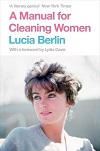Content warning: includes mentions of death and suicide
Lucia Berlin’s entrance into the literary canon was swift and unexpected: 11 years after her death, the short story collection A Manual for Cleaning Women became a bestseller. But why now? Why not during her lifetime? A discussion of both her talent and the canonical oversight.
By Hanna-Maria Vester
Picture: von Sophie Taeuber-Arp via Wikimedia Commons, gemeinfrei
In considering authors beyond the canon, Lucia Berlin occupies a particular position. For the longest time, her work did not spark widespread fame or recognition. But this ›insider tip‹ of a short story writer has now found her way onto bestseller lists – posthumously. »The greatest American writer you’ve never heard of« and »America’s best kept secret« are, fortunately, becoming less and less true assertions thanks to one particular publication. The short story collection A Manual for Cleaning Women published in 2015 by Farrar, Straus and Giroux contains 43 of Berlin’s stories, selected by her friend and fellow writer Stephen Emerson. After years of her work being enjoyed by smaller readerships – a lucky bunch of one to two thousand readers – this collection finally flew off the shelves. The success of Berlin provides an opportunity to not only discuss her talent for the form, but also possible reasons for why she was overlooked by most readers and academics in the twentieth century.
A Master of the Form
Although she made two attempts at novel-writing, Lucia Berlin exclusively published short stories. They begin with characteristic immediacy. »›Ma, I can’t believe you are doing this. You never even go out with anybody, and here you are spending a week with some stranger. He could be an axe murderer for all you know‹«; »Wait. Let me explain…«; and probably most ›Berlin‹ of all: »Got into Albuquerque from Baton Rouge. It was about two in the morning. Whipping wind«. No wasted words. Berlin’s endings are similarly remarkable, organically built and pulling no punches. In Phantom Pain, she describes a woman named Lu who regularly visits her wheelchair-bound father at a nursing home. Eventually, he begins to forget her and becomes cruel and violent. The story ends with the two of them alone on top of a hill: »He loosened his brakes and the chair started down the brick path. I hesitated, stood there watching it, but then I threw away my cigarette and caught his chair just as it was picking up speed«.
Series
Leaving the well-trodden paths of the literary canon behind, the authors of this series deal with poets, thinkers, writers whose work too often unjustly resides in the shadows of canonical texts. An opportunity for rediscovery, with further articles to be published here.
It’s not just the beginnings and the endings, but what happens in between. Renowned short story author Lydia Davis never met Berlin in person, but was a fan of her writing and became an epistolary friend of hers. In the Introduction of Cleaning Women, Davis attempts to describe Berlin’s appeal, contemplating her engaging narrative voice and her lyrical economy and clarity. It is hard to put down one of Berlin’s stories mid-read because of their remarkable density. The writer conjures up entire worlds in a matter of pages. In the ᾽90s, she taught writing at Colorado University, advising students not to rely on ›cleverness‹. A story, she argued, had to be felt and imbued with emotional authenticity. This commitment to ›realness‹ is a hallmark of her work: »In any good piece of writing it is not an identification with a situation, but this recognition of truth that is thrilling«, she told Davis.
A Study in Death
And the truths she tries to get at are manifold. Not just Phantom Pain, but a number of stories in A Manual for Cleaning Women are a consideration of mortality, for instance. Emergency Room Notebook, 1977 is told from the perspective of a woman working at a hospital, possibly as a registration clerk. To her, it is a study in death, a tightrope walk between detachment and compassion. She describes the rhythm in the hospitals, the anticipatory bustle at a code three (»where life is in critical danger«), juxtaposed with people like »Marlene the Migraine, an Emergency habituée«, people almost aggressively alive. Sometimes, she asserts that a patient »always seemed dead anyway, but nicely so, like an illustration or advertisement«. Other times, she grieves the dead – and her own loneliness.
In the title story, A Manual for Cleaning Women, the narration of a woman cleaning houses is structured by bus routes, eccentric employers and routines. Playing with expectations, the narrator claims that
cleaning women do steal. Not the things that people we work for are so nervous about. It is the superfluity that gets to you. We don’t want the change in the little ashtrays.
Instead, the woman puts an extra dime where people want to tempt her with money lying around. The humour in Berlin’s writing is light, unexpected, and easily meets with the unforeseeable dark:
All I really steal is sleeping pills, saving up for a rainy day.
The narrator collects advice for fellow cleaning women, urging them, for example, to thankfully accept any gift from their employers (»You can leave it on the bus, in the crack«). But she also quietly collects pills. The references to them, her husband’s death and the subsequent loss of their former home are sparse and therefore ever more alarming.
The Author is Dead, Long Live the Author
Berlin writes about mortality, alcoholism, routines and chance encounters. Most of all, she writes the everyday from which she extracts the extraordinary with precision, (dark) humour and an entrancing pace and rhythm. 77 short stories were published in several collections during her life time, among them Homesick for which she received an American Book award. Her literary home were small presses such as Black Sparrow. She began writing in earnest in her early twenties during the late 1950s, affiliating with artists, musicians and writers, sculptors, jazz pianists, Beats. With her mentor Edward Dorn, the Black Mountain poet, she fostered a life-long literary friendship. Her publications occurred twenty years later. During the twenty years in-between, she worked many different jobs and moved a lot. One the side, she kept feverishly writing, editing and corresponding with other authors. For her, it was a time of general upheaval: three husbands, four children and one near-constant problem with alcoholism.

Lucia Berlin’s undoubtedly exciting life seminally influenced her writing and was featured prominently in countless reviews and articles since Cleaning Women. The publication of another collection and a memoir, beautifully arranged with photos and letters, further intensified the cult around Berlin. However, it seems advisable to tread with caution in discussing her work as ›auto-fiction‹. There is no denying that she is a fascinating person, but side by side, the memoir and the collections invite speculation. Reading her short stories can easily turn into the hunt for biographical nuggets, encounters reminiscent of Berlin’s own experiences. The occasional similarities may be startling at times. Even one of Berlin’s sons sometimes confused his mother’s writing with his own memories. But she told him it »didn’t matter: the story is the thing«. While her life was eventful indeed, so are her stories – in their own right – especially when considering their literary merit.
A Day Has 24 Hours
To a certain degree, it thus seems advisable to ignore the ›auto‹ in her writing. Yet, Berlin’s biography explains why she remained on the periphery of the US-American literary scene. Journalists miscategorising her writing as ›dirty realism‹ didn’t help. Additionally, Bridget Read asserts that when we talk of literary maestros, we too often mean men, especially when it comes to short story writers. The milieu in which Berlin moves during the ᾽50s and ᾽60s is exemplary for not only this reception of literature, but also the discourses it inspires. While her male friends, Black Mountain poets Edward Dorn and Robert Creeley discussed music and poetry, the women »cooked, folded laundry, tended to the children«. Yet, it was with Dorn especially that she began to develop a rapport on literature. While authors like Creeley dismissed Berlin’s writing as dilettante, Dorn helped her to explore and improve her writing, providing epistolary feedback.
Berlin is now being compared to big names in the Anglophone short story canon, both male and female. One such an author is Tillie Olsen, feminist writer and working mother herself. On her small literary output, Margaret Atwood wrote:
A day has 24 hours. For 20 years she had no time, no energy and none of the money that would have bought both.
Writing is a profession that many practise on the side before they are, if they are lucky, able to call themselves full-time writers. Women were (and still are) more prone to taking on the labour of child-rearing, which renders this career path an even loftier goal. For Berlin, caring for her children and making sure they had a place to live necessarily took precedence over writing, even if it also inspired it. As Marie Crum writes, »in contrast to that largely male cohort [of Beat writers], Berlin’s search – the desperation that compelled her to pour out her stories – was often more material than existential«.
In/Evitably an Outsider

Lucia Berlin
A Manual for Cleaning Women: Selected Stories
Picador: London 2016
432 pages, £9,99
Unlike the Beats’, Crum asserts, her »characters, plucked from Berlin’s adult life, didn’t go on adventures«. Therein lies the paradox of her writing. It is impeded, yet fuelled, by her socio-economic and family situation. Berlin’s circumstances seep into it and flow through its pulsating, interlacing veins: stories set at variable cities in North-America (and occasionally Middle-America), stories about laundromats, teaching, cleaning houses and working at hospitals. It is her unsettled home and work life that gives her writing shape; that grounds it. And yet, it is also the main reason why Berlin never had the time to make a name for herself in the literary world. The editor of Cleaning Women, Stephen Emerson, professes that it is her outsider-status that endows her work with »its special strength«. The »constraints of the small-press audience« might thus have been »inevitable«. But this inevitability is questionable and should be subject to analytical scrutiny. It certainly is not a coincidence.
Said inevitability has not stood the test of time and Berlin is now widely read, with editions published in 30 countries and a broad US-readership. Her resurgence fits nicely with the rise of auto-fiction and a focus on voices from the margins that mark prevalent literary trends. Rightfully, her canonisation has begun and she sits comfortably with the likes of Grace Paley, Lydia Davis and Raymond Carver. Hopefully, her work will be featured on syllabi more frequently – as of yet, no far-reaching academic analyses and treatises have been conducted.1If an academic study on Berlin’s writing does exist, it seems to be well-hidden, elusive and neither widley accessible nor extensively talked about. But her stories are worth analysing as quintessentially US-American short stories at its finest, tracing differing spaces the country encompasses and the intricacies of everyday and domestic life they comprise.
When authors like Berlin come along – and deign to come around a second time, even – the scholarly community should ideally make sure to include her and female writers like her to increase recognition, and, quite simply, canonical balance. As Stephen Reid puts it,
we are not living through a renaissance of women writers; we are achieving a glimpse (…) at the possibilities missed, of the possible art that our culture is now deprived of, because of the opportunities our society denied women in the past. We cannot afford any more denials.






